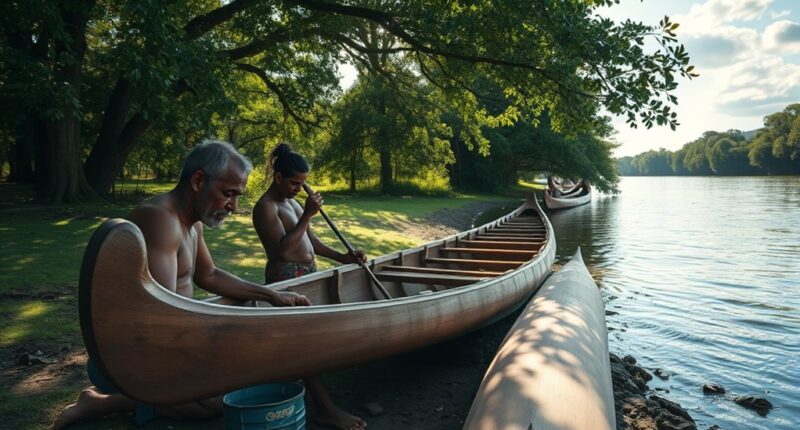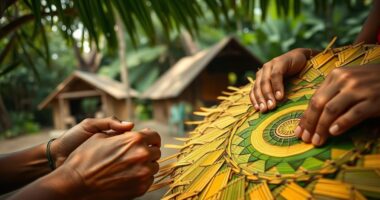Building a traditional canoe connects you to a rich cultural heritage, using local materials and ancient techniques to carve and shape the vessel by hand. You’ll learn how artisans waterproof and decorate their canoes with symbols that tell stories and honor beliefs. This craft not only helps navigate rivers and sea country but also sustains community ties and environmental harmony. If you explore further, you’ll discover how these practices keep culture alive and foster harmony with nature.
Key Takeaways
- Traditional canoe building involves selecting durable, locally sourced woods to ensure seaworthiness and river navigation.
- Craftsmanship techniques include carving and hollowing with ancestral tools, reflecting cultural heritage.
- Natural sealing methods waterproof canoes, enabling safe travel across rivers and sea.
- Decorative patterns and symbols on canoes express spiritual beliefs and tribal identities.
- Building canoes preserves cultural knowledge and promotes harmony with the environment during navigation.

Have you ever wondered how indigenous artisans craft their traditional canoes? These vessels are more than just transportation; they embody a deep connection to their land, sea, and community. Indigenous craftsmanship plays a crucial role in preserving cultural identity, passing down centuries-old techniques that have been refined through generations. When you observe the careful process of building a canoe, you’re witnessing a living tradition that maintains the cultural fabric of these communities. Each step, from selecting the right wood to shaping and sealing the vessel, reflects a profound respect for nature and a commitment to cultural preservation. These artisans don’t just build boats—they safeguard their history, stories, and spiritual beliefs embedded within every piece.
The process starts with choosing the appropriate materials, often locally sourced woods that have been used by their ancestors for centuries. You might notice how specific types of trees are favored for their durability and buoyancy, embodying a sustainable relationship with the environment. The artisans then carve and hollow out the wood using traditional tools, a skill passed down through countless generations. This craftsmanship demands patience, precision, and intimate knowledge of the materials, which helps guarantee the canoe’s strength and seaworthiness. As they shape the hull, they’re not only constructing a functional vessel but also engaging in a ritual that reinforces their cultural identity. Every cut and notch bears the mark of ancestral techniques, connecting the present to the past.
Sealing and decorating the canoe is equally important. Indigenous artisans often apply natural resins or plant-based substances to waterproof the vessel, a step that reflects their resourcefulness and harmony with nature. Decorative elements—patterns, symbols, and colors—are added to express stories, spiritual beliefs, or tribal affiliations. These embellishments transform the canoe into a cultural artifact, a moving symbol of community history. Building canoes this way isn’t simply about functionality; it’s a form of cultural preservation that strengthens the community’s ties to their land, sea country, and heritage. Through this craftsmanship, they continue to honor their ancestors’ knowledge, guaranteeing that these traditional skills endure for future generations, navigating not just waters but the very essence of their cultural identity. Additionally, the use of sustainable materials underscores their relationship with nature, ensuring the practice remains environmentally harmonious.
Frequently Asked Questions
How Do Traditional Canoe Builders Choose Their Wood Materials?
You choose your wood materials by prioritizing sustainable sourcing, ensuring the environment remains healthy. You look for specific types of wood known for their strength, flexibility, and durability, such as certain native species. You consider the wood’s grain and moisture content, making sure it’s suitable for canoe building. By selecting responsibly sourced, high-quality wood, you honor tradition and protect the land, sea, and riverways you navigate.
What Tools Are Essential for Traditional Canoe Construction?
Imagine you’re crafting a canoe using ancient tools passed down through generations, embodying ceremonial craftsmanship. Essential tools include adzes, for shaping wood, and knives, for detailed carving. You might also use chisels and gouges to refine the shape. These tools honor tradition and guarantee precision. Their use connects you to a rich cultural heritage, making each canoe not just a vessel, but a piece of living history.
How Long Does It Typically Take to Build a Traditional Canoe?
Building a traditional canoe usually takes several weeks to months, depending on the complexity and your skill level. During this time, you’ll focus on canoe maintenance to guarantee durability and respect its cultural significance. The process involves careful craftsmanship, often passed down through generations, reflecting deep cultural connections. Patience is key, as each step honors tradition while creating a vessel that’s essential for steering rivers and sea country.
Are There Specific Rituals Involved in the Canoe-Building Process?
You’re immersed in a sacred act where every stroke and knot holds the universe’s secrets. Yes, specific rituals are involved, like spiritual ceremonies that honor ancestral spirits, infusing the canoe with their power. These rituals carry deep significance, transforming simple wood into a vessel of cultural heritage and spiritual connection. You feel the weight of tradition in every step, ensuring the canoe’s journey is blessed and protected by ancestral spirits.
How Do Traditional Canoes Adapt to Different Water Conditions?
You adapt traditional canoes to different water conditions through water flow techniques and canoe design modifications. For swift rivers, you might choose a narrower, lighter canoe to improve maneuverability, while for open sea travel, a wider, more stable design helps handle waves. You also incorporate specific paddling techniques to navigate currents effectively, ensuring safety and efficiency across diverse water environments.
Conclusion
As you paddle your handmade canoe, you’ll feel like the ruler of every river and sea, commanding waves and currents with the grace of a legendary navigator. Every stroke will echo centuries of tradition, making you feel like an ancient explorer reborn. Your canoe isn’t just a boat; it’s a magical vessel bridging worlds, stories, and spirits. With each journey, you’ll become a hero of waterways, conquering oceans and rivers with the power of tradition behind you.









